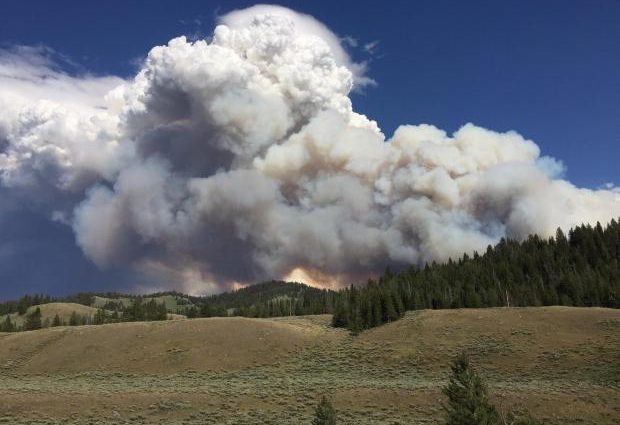
Jackson Hole Daily, Mike Koshmrl- With about half of the wildfire season to go, Jackson Hole’s firefighters have been busy enough that they have called in reinforcements to assist with their routine day-to-day operations.
Although the largest of northwest Wyoming’s wildfires — the Cliff Creek and Lava Mountain fires — have died down, there hasn’t been a lull in activity everywhere. On the west side of Jackson Lake the now 617-acre Berry Fire has grown by bounds in the past week and at times has put up a good-size smoke column.
Elsewhere in the region there has been plenty of activity as well, said Bridger-Teton National Forest fire program manager Mike Johnston.
“Last week especially, we were getting two or three fires a day,” Johnston said. “Almost all of them were in the frontcountry, so they almost automatically dictated a suppression response under these fire conditions.”
A Teton Interagency Fire gauge that measures the dryness and quantity of wildfire fuels, called an “energy release component,” is running at about the 90th percentile for this point in the summer. In other words, only one out of 10 times in the third week in August is the forest as ripe for burning as it is right now.
On portions of the Bridger-Teton, including near Kemmerer and in the Wind River Range, the fuels are at a record level of dryness, Johnston said.
The desiccated downed logs, twigs and grasses are part of the reason Teton Interagency Fire officials requested and were granted outside resources to assist with routine monitoring and suppression.
“We got several folks from other areas right here helping us out,” Johnston said. “By ourselves, we can’t keep up with our workload right now.”
Firefighters have also had their hands full in Yellowstone National Park, where five fires are burning, three of which exceed 1,000 acres.
The Maple Fire east of West Yellowstone, Montana, which had swelled to 19 square miles by Thursday, is the largest. It’s burning in short grass and timber primarily within the burn scar from 1988’s massive North Fork Fire.
“That’s the first time since ’88 that we’ve seen significant fire activity in those scars,” Johnston said.
Further south on the remote yet visible Berry Fire, Grand Teton National Park has brought in a 25-man crew to keep tabs on the blaze. Burning near the confluence of Owl and Berry creeks about 3 miles west of Jackson Lake, the wildfire is deemed nonthreatening and is being allowed to burn.
“Really the only impacts right now are the trail closures and, occasionally, when it’s growing quite a bit some smoke impacts along the highway,” fire information officer David Eaker said.
The Lower Berry Patrol Cabin, he said, is the only structure in the area that fire managers are concerned about at the time being. Trails closed by the Berry Fire include the Glade Creek Trail, Owl-Berry cutoff trail, Berry Creek Trail from Glade Creek to Hechtman and also the Owl Creek Trail 3 miles west of the cutoff to the Webb Canyon junction.
The Berry Fire could continue burning into the fall, as could the still-smoldering and almost completely contained Cliff Creek and Lava Mountain fires.
The fire danger in the Jackson Hole area remains “very high,” with some campfire restrictions in effect.
“It’s been a long fire season,” Johnston said. “We’re basically at the mid-point, and this could go until mid-October. We see our most significant fire behavior in September some years.”
